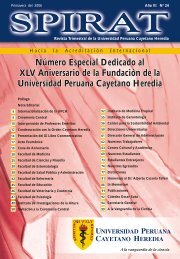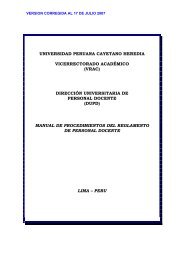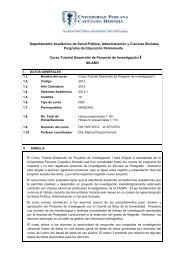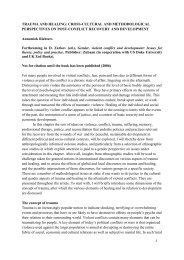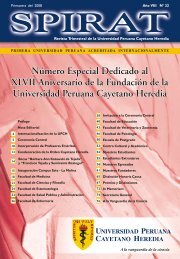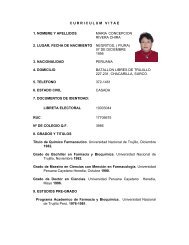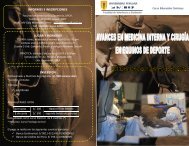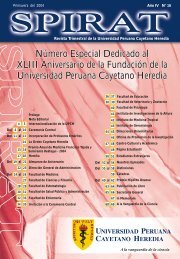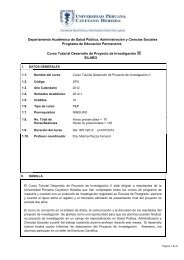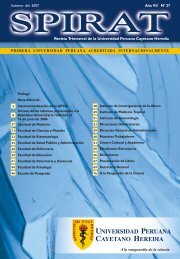Herbivore-induced, indirect plant defences - UPCH
Herbivore-induced, indirect plant defences - UPCH
Herbivore-induced, indirect plant defences - UPCH
Create successful ePaper yourself
Turn your PDF publications into a flip-book with our unique Google optimized e-Paper software.
G. Arimura et al. / Biochimica et Biophysica Acta 1734 (2005) 91–111 107biosynthesis: isolation, functional characterization, and developmentalregulation of Cstps1, a key gene in the production ofthe sesquiterpene aroma compound valencene, Plant J. 36 (2003)664–674.[106] B. Miller, L.L. Madilao, S. Ralph, J. Bohlmann, Insect-<strong>induced</strong>conifer defense. White pine weevil and methyl jasmonate inducetraumatic resinosis, de novo formed volatile emissions, andaccumulation of terpenoid synthase and putative octadecanoidpathway transcripts in sitka spruce, Plant Physiol. 137 (2005)369–382.[107] M. Kunert, A. Biedermann, T. Koch, W. Boland, Ultrafast samplingand analysis of <strong>plant</strong> volatiles by a hand-held miniaturised GC withpre-concentration unit: kinetic and quantitative aspects of <strong>plant</strong>volatile production, J. Sep. Sci. 25 (2002) 677–684.[108] G. Arimura, R. Ozawa, S. Kugimiya, J. Takabayashi, J. Bohlmann,<strong>Herbivore</strong>-<strong>induced</strong> defense response in a model legume: two-spottedspider mites, Tetranychus urticae, induce emission of (E)-h-ocimeneand transcript accumulation of (E)-h-ocimene synthase in Lotusjaponicus, Plant Physiol. 135 (2004) 1976– 1983.[109] J. Lqcker, H.J. Bouwmeester, W. Schwab, J. Blaas, L.H.W. van derPlas, H.A. Verhoeven, Expression of Clarkia S-linalool synthase intransgenic petunia <strong>plant</strong>s results in the accumulation of S-linalyl-hd-glucopyranoside,Plant J. 27 (2001) 315–324.[110] A. Aharoni, A.P. Giri, S. Deuerlein, F. Griepink, W.J. de Kogel,F.W.A. Verstappen, H.A. Verhoeven, M.A. Jongsma, W. Schwab,H.J. Bouwmeester, Terpenoid metabolism in wild-type and transgenicArabidopsis <strong>plant</strong>s, Plant Cell 15 (2003) 2866–2884.[111] J. Donath, W. Boland, Biosynthesis of acyclic homoterpenes inhigher <strong>plant</strong>s parallels steroid hormone metabolism, J. Plant Physiol.143 (1994) 473–478.[112] J. Degenhardt, J. Gershenzon, Demonstration and characterization of(E)-nerolidol synthase from maize: a herbivore-inducible terpenesynthase participating in (3E)-4,8-dimethyl-1,3,7-nonatriene biosynthesis,Planta 210 (2000) 815–822.[113] G. Arimura, R. Ozawa, T. Shimoda, T. Nishioka, W. Boland, J.Takabayashi, Herbivory-<strong>induced</strong> volatiles elicit defence genes inlima bean leaves, Nature 406 (2000) 512–515.[114] S. Seo, H. Seto, H. Koshino, S. Yoshida, Y. Ohashi, A diterpene asan endogenous signal for the activation of defense responses toinfection with tobacco mosaic virus and wounding in tobacco, PlantCell 15 (2003) 863–873.[115] A. Hatanaka, The biogeneration of green odour by green leaves,Phytochemistry 34 (1993) 1201–1218.[116] K. Matsui, S. Kurishita, A. Hisamitsu, T. Kajiwara, A lipidhydrolysingactivity involved in hexenal formation, Biochem. Soc.Trans. 28 (2000) 857–860.[117] E. Alméras, S. Stolz, S. Vollenweider, P. Reymond, L. Méne-Saffrané, E.E. Farmer, Reactive electrophile species activate defensegene expression in Arabidopsis, Plant J. 34 (2003) 205–216.[118] M.A. Farag, P.W. Paré, C 6 -Green leaf volatiles trigger localand systemic VOC emissions in tomato, Phytochemistry 61 (2002)545–554.[119] N.J. Bate, S.J. Rothstein, C 6 -volatiles derived from the lipoxygenasepathway induce a subset of defense-related genes, Plant J. 16 (1998)561–569.[120] G. Arimura, R. Ozawa, J. Horiuchi, T. Nishioka, J. Takabayashi,Plant–<strong>plant</strong> interactions mediated by volatiles emitted from<strong>plant</strong>s infested by spider mites, Biochem. Syst. Ecol. 29 (2001)1049–1061.[121] J. Engelberth, H.T. Alborn, E.A. Schmelz, J.H. Tumlinson, Airbornesignals prime <strong>plant</strong>s against insect herbivore attack, Proc. Natl. Acad.Sci. U. S. A. 101 (2004) 1781–1785.[122] D.F. Hildebrand, G.C. Brown, D.M. Jackson, T.R. Hamilton-Kemp,Effects of some leaf-emitted volatile compounds on aphid populationincrease, J. Chem. Ecol. 19 (1993) 1875–1887.[123] G. Vancanneyt, C. Sanz, T. Farmaki, M. Paneque, F. Ortego, P.Castanera, J.J. Sánchez-Serrano, Hydroperoxide lyase depletion intransgenic potato <strong>plant</strong>s leads to an increase in aphid performance,Proc. Natl. Acad. Sci. U. S. A. 98 (2001) 8139–8144.[124] H.W. Gardner, D.L.J. Dornbos, A.E. Desjardins, Hexanal, trans-2-hexenal, and trans-2-nonenal inhibit soybean, Glycine max, seedgermination, J. Agric. Food Chem. 38 (1990) 1316–1320.[125] T.R. Hamilton-Kemp, J.H. Loughrin, D.D. Archbold, R.A. Andersen,D.F. Hildebrand, Inhibition of pollen germination by volatilecompounds including 2-hexenal and 3-hexenal, J. Agric. FoodChem. 39 (1991) 952–956.[126] T.C. Turlings, J.H. Loughrin, P.J. McCall, U.S. Rose, W.J. Lewis,J.H. Tumlinson, How caterpillar-damaged <strong>plant</strong>s protect themselvesby attracting parasitic wasps, Proc. Natl. Acad. Sci. U. S. A. 92(1995) 4169–4174.[127] U.S.R. Röse, J.H. Tumlinson, Volatiles released from cotton <strong>plant</strong>s inresponse to Helicoverpa zea feeding damage on cotton flower buds,Planta 218 (2004) 824–832.[128] E.E. Farmer, C.A. Ryan, Inter<strong>plant</strong> communication: airborne methyljasmonate induces synthesis of proteinase inhibitors in <strong>plant</strong> leaves,Proc. Natl. Acad. Sci. U. S. A. 87 (1990) 7713–7716.[129] H.S. Seo, J.T. Song, J.J. Cheong, Y.H. Lee, Y.W. Lee, I. Hwang, J.S.Lee, Y.D. Choi, Jasmonic acid carboxyl methyltransferase: a keyenzyme for jasmonate-regulated <strong>plant</strong> responses, Proc. Natl. Acad.Sci. U. S. A. 98 (2001) 4788–4793.[130] M.A. Birkett, C.A.M. Campbell, K. Chamberlain, E. Guerrieri, A.J.Hick, J.L. Martin, M. Matthes, J.A. Napier, J. Pettersson, J.A.Pickett, G.M. Poppy, E.M. Pow, B.J. Pye, L.E. Smart, G.H.Wadhams, L.J. Wadhams, C.M. Woodcock, New roles for cisjasmoneas an insect semiochemical and in <strong>plant</strong> defense, Proc. Natl.Acad. Sci. U. S. A. 97 (2000) 9329–9334.[131] C.C. von Dahl, I.T. Baldwin, Methyl jasmonate and cis-jasmone donot dispose of the herbivore-<strong>induced</strong> jasmonate burst in Nicotianaattenuata, Physiol. Plant. 120 (2004) 474–481.[132] J.C. D’Auria, F. Chen, E. Pichersky, The SABATH family of MTs inArabidopsis thaliana and other <strong>plant</strong> species, in: J.T. Romeo (Ed.),Recent Advances in Phytochemistry, Elsevier Science Ltd., Oxford,2003, pp. 253–283.[133] F. Chen, J.C. D’Auria, D. Tholl, J.R. Ross, J. Gershenzon, J.P. Noel,E. Pichersky, An Arabidopsis thaliana gene for methylsalicylatebiosynthesis, identified by a biochemical genomics approach, has arole in defense, Plant J. 36 (2003) 577–588.[134] V. Shulaev, P. Silverman, I. Raskin, Airborne signalling bymethyl salicylate in <strong>plant</strong> pathogen resistance, Nature 385 (1997)718–721.[135] M. Frey, C. Stettner, P.W. Paré, E.A. Schmelz, J.H. Tumlinson, A.Gierl, An herbivore elicitor activates the gene for indole emission inmaize, Proc. Natl. Acad. Sci. U. S. A. 97 (2000) 14801–14806.[136] M. Frey, D. Spiteller, W. Boland, A. Gierl, Transcriptional activationof Igl, the gene for indole formation in Zea mays: a structure–activitystudy with elicitor-active N-acyl glutamines from insects, Phytochemistry65 (2004) 1047–1055.[137] M. Dicke, L.E.M. Vet, Plant–carnivore interactions: evolutionary andecological consequences for <strong>plant</strong>, herbivore and carnivore, in: R.H.Drent (Ed.), <strong>Herbivore</strong>s: Between Plants and Predators, BlackwellScience, Oxford, 1999, pp. 483–520.[138] M. Dicke, Specifity of herbivore-<strong>induced</strong> <strong>plant</strong> <strong>defences</strong>, in: J.A.Goode (Ed.), Insect–Plant Interactions and Induced Plant Defence,John Wiley & Sons, Ltd., Chichester, 1997.[139] T.C.J. Turlings, F.L. W7ckers, L.E.M. Vet, J.M. Lewis, J.H.Tumlinson, Learning of host-finding cues by hymenopterousparasitoids, in: A.C. Lewis (Ed.), Insect Learning — Ecologyand Evolutionary Perspectives, Chapman & Hall, New York, 1993,pp. 51–78.[140] E.N. Barata, J.A. Pickett, L.J. Wadhams, C.M. Woodcock, H.Mustaparta, Identification of host and nonhost semiochemicalsof eucalyptus woodborer Phoracantha semipunctata by gas chromatography-electroantennography,J. Chem. Ecol. 26 (2000)1877–1895.




